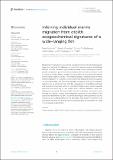Files in this item
Inferring individual marine migration from otolith ecogeochemical signatures of a wide-ranging fish
Item metadata
| dc.contributor.author | Hanson, Nora | |
| dc.contributor.author | Ounsley, James | |
| dc.contributor.author | Middlemas, Stuart J. | |
| dc.contributor.author | Gilbey, John | |
| dc.contributor.author | Todd, Christopher D. | |
| dc.date.accessioned | 2023-05-04T16:30:05Z | |
| dc.date.available | 2023-05-04T16:30:05Z | |
| dc.date.issued | 2022-12-14 | |
| dc.identifier | 284812628 | |
| dc.identifier | 816c5fac-bd70-4a8b-9174-8826d5d877bc | |
| dc.identifier | 85145051121 | |
| dc.identifier.citation | Hanson , N , Ounsley , J , Middlemas , S J , Gilbey , J & Todd , C D 2022 , ' Inferring individual marine migration from otolith ecogeochemical signatures of a wide-ranging fish ' , Frontiers in Marine Science , vol. 9 , 1071081 . https://doi.org/10.3389/fmars.2022.1071081 | en |
| dc.identifier.issn | 2296-7745 | |
| dc.identifier.other | ORCID: /0000-0002-9690-2839/work/134056074 | |
| dc.identifier.uri | https://hdl.handle.net/10023/27514 | |
| dc.description | Funding Information: This study was supported by funding from the Scottish Government. Access to the EIMF instruments was supported by grant numbers 383/1109 and 415/1010 from the Natural Environment Research Council. | en |
| dc.description.abstract | Despite technical advances in archival tag attachment and functional longevity, long-term tracking of individuals of some fish species remains prohibitively difficult. Here we combined high resolution stable isotope sampling of otoliths, genetic assignment, growth increment analyses and a simple movement model to inform a hidden Markov model of the location of individual wild Atlantic salmon (Salmo salar L.) at sea. The model provided a reconstruction of North Atlantic migration for a species which is extremely difficult to track throughout its marine life-stage. We show that plausible emigration and return migration patterns can be achieved from wild fish. Simulations of simplified northward and westward movement patterns in the North Atlantic were used to quantify precision and accuracy of the model which differed between these two directional scenarios. Because otolith-derived migratory information does not rely on capture, release and subsequent recapture of the individual, this can be retrieved from any fish. Thus these techniques offer a powerful tool for improving our understanding of the processes that govern movement and survival of individual fish during a protracted and largely unobservable life-stage in the oceanic environment. | |
| dc.format.extent | 13 | |
| dc.format.extent | 3342160 | |
| dc.language.iso | eng | |
| dc.relation.ispartof | Frontiers in Marine Science | en |
| dc.subject | Hidden Markov model | en |
| dc.subject | Isotope | en |
| dc.subject | Migration | en |
| dc.subject | Otolith | en |
| dc.subject | Salmon | en |
| dc.subject | Sea surface temperature | en |
| dc.subject | QL Zoology | en |
| dc.subject | SH Aquaculture. Fisheries. Angling | en |
| dc.subject | Aquatic Science | en |
| dc.subject | Oceanography | en |
| dc.subject | Ocean Engineering | en |
| dc.subject | Environmental Science (miscellaneous) | en |
| dc.subject | Global and Planetary Change | en |
| dc.subject | Water Science and Technology | en |
| dc.subject | DAS | en |
| dc.subject | SDG 10 - Reduced Inequalities | en |
| dc.subject | SDG 14 - Life Below Water | en |
| dc.subject | MCC | en |
| dc.subject.lcc | QL | en |
| dc.subject.lcc | SH | en |
| dc.title | Inferring individual marine migration from otolith ecogeochemical signatures of a wide-ranging fish | en |
| dc.type | Journal article | en |
| dc.contributor.institution | University of St Andrews. School of Biology | en |
| dc.contributor.institution | University of St Andrews. Marine Alliance for Science & Technology Scotland | en |
| dc.contributor.institution | University of St Andrews. Scottish Oceans Institute | en |
| dc.identifier.doi | 10.3389/fmars.2022.1071081 | |
| dc.description.status | Peer reviewed | en |
This item appears in the following Collection(s)
Items in the St Andrews Research Repository are protected by copyright, with all rights reserved, unless otherwise indicated.

